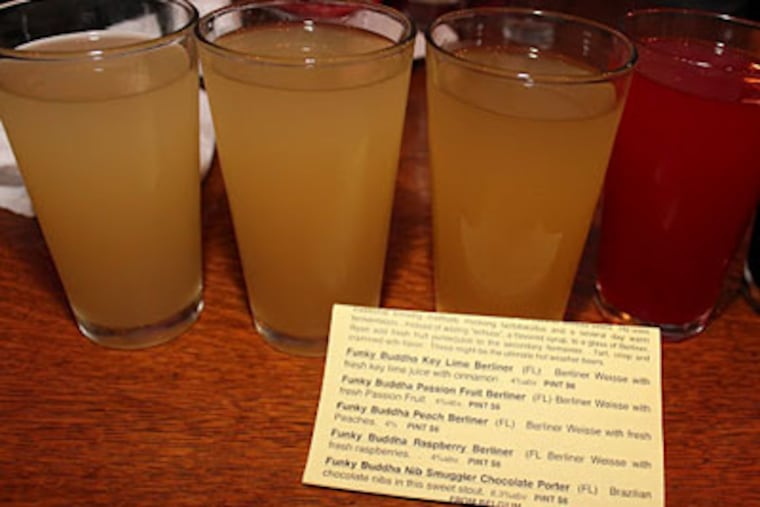Kimchi beer, anyone? How homebrewers are pushing brewing boundaries
IF YOU WANT to know where beer is headed tomorrow, find a homebrewer today and drink his or her beer. This shouldn't come as a surprise. It was homebrewers, after all, who launched the microbrewing revolution by turning pro. And it was homebrewers who originated many of the recipes that were refined for commercial products.

IF YOU WANT to know where beer is headed tomorrow, find a homebrewer today and drink his or her beer.
This shouldn't come as a surprise. It was homebrewers, after all, who launched the microbrewing revolution by turning pro. And it was homebrewers who originated many of the recipes that were refined for commercial products.
Judging by the homebrews I sampled throughout Philly Beer Week, I'd say we're in for a round of big, unusual flavors that taste a lot better than they sound. For example: Salted Caramel Chocolate Stout.
Yeah, it sounds like a treat you'd munch on the Wildwood Boardwalk. But this rich, dark ale was superb; I'd gladly drink another glass.
It was crafted by Sean and Andy Arsenault, 30-year-old South Philly twins who have been brewing together for about five years. The beer was the "People's Choice" at Home Sweet Homebrew's Extreme Home Brew Challenge at Jose Pistola's in Center City. "We just kind of winged it," said Sean, an engineer. Andy is a professional, working at Victory Brewing, where the beer tends to be decidedly more conventional.
Sean said he was inspired to duplicate the flavor of the salted caramel ice cream he enjoyed while living in Lyon, France. It was made with English brown malt, the type used in mild stout and porter, plus sugar and a dose of lactose to amplify its sweetness. Only a small bit of sea salt was added to give it the kick it needed.
While many homebrewers are still pursuing prosaic pilsners, there's a growing subset of do-it-yourselfers who do it to the extreme. "It's just a chance for us to spread our wings a bit," Andy Arsenault said.
Thus, during Beer Week, I tasted varieties made with licorice and mugwort and heather and pepper and blood orange and banana. I enjoyed a jalapeño espresso porter and a honey-and-vanilla imperial stout. And I splashed back a shot of stout aged in oak that is appropriately named Lemmy, after Motörhead's whiskey-swilling frontman, because, the brewer reasoned, it was made with an "ample" pour of Jack Daniel's.
And then there was the kimchi brew.
That's right: beer made with fermented cabbage. Made by Jimmy McMillan, co-owner of Barry's Homebrew Outlet in North Philly, that strange one was served at Memphis Taproom's annual Home Brew Beer Fest. When taproom co-owner Leigh Maida got a taste, she described its flavor as "the same you get from a post-pepper burp."
Yum!
How did homebrewing get so weird? "A lot of it is the Dogfish Head influence," explained Tim Patton, a longtime homebrewer aiming to open his own commercial brewery near the Temple University campus. Dogfish Head, of course, is known for its many unusual flavors, from the beet sugar and raisins of Raison D'être to the pureed raspberries of Fort to the rooibos tea of Urkontinent. Founder and president Sam Calagione's Extreme Brewing is a mainstay on the bookshelves of hundreds of homebrewers.
More broadly, Patton said, beer drinkers are increasingly enjoying the exotic flavor of Belgian ales — tart Flemish brown ale, spicy saison and funky lambic. None tastes like what we used to call "normal" beer, he said, "and now there's no definition of what beer is supposed to taste like."
We've already seen the impact on corporate beer. Anheuser-Busch, for example, bottles beer that tastes like lemon, blueberry, tomato and pumpkin spice.
Small brewers are taking it yet another step. The talk of Philly Beer Week, for example, was No Crusts from Florida's Funky Buddha Lounge & Brewery, a brown ale that tasted like peanut butter and jelly.
Still, there's no better place to see how far the envelope can be pushed than at a homebrew event. That's mainly because, as homebrewer Christina Burris noted, "It's much easier and cheaper to risk five gallons than a 30-barrel batch."
That's why her collaborators at the burgeoning home-based Bombshell Brewery didn't overly object when she suggested adding lavender to their saison recipe. It was just one small batch, but the payoff was big: a sensual, spicy flavor that would've been at home in a picnic basket on a summer day in the park.
Too delicate? How about chocolate and peppers? A homebrew club called Speed Bump Brewery crafted a Smoked Habanera Dunkelweisse that was served in glasses rimmed with a powdered mix of cocoa, sugar and bacon bits.
Really love your bacon? Ryan Hudak, who calls his outfit Gnarly Beard Brewing, turned out a Canadian bacon IPA, an unusual combination of smoked malts and aromatic Magnum hops. "I'm happy with it," Hudak told me, "I just didn't want it to taste like a dirty ashtray."
Well, even homebrewing has its limits.